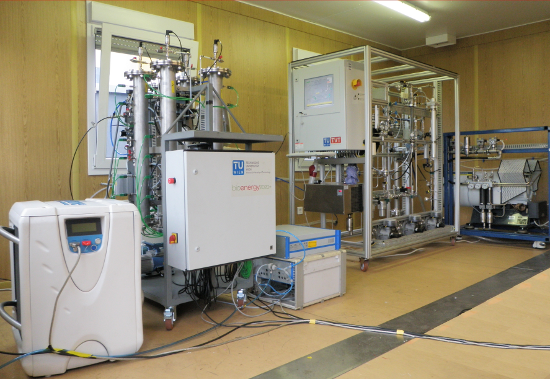Decentral Green H2
The Decentral Green H2 project of the Institute of Chemical, Environmental and Bioscience Engineering at TU Wien aims at recovering hydrogen from biomass to utilize it for carbon neutral, efficient and decentralized power and heat generation.
Background
Hydrogen is regarded as the energy source of the future especially when obtained from renewable natural resources. Producer gas originating from thermal biomass steam gasification in a dual fluidized bed primarily consists of hydrogen (35-45 vol% standard gasification, 67-75% SER-gasification). This gasification technology was proven on an industrial scale and thus represents an up-and-coming technology to produce hydrogen sustainably.
Next to hydrogen, carbon monoxide CO, carbon dioxide CO2, methane CH4 and ethylene C2H4 appear as main components as a result of the gasification. Secondary components consist of higher hydrocarbons such as ethane, acetylene, BTX, naphthalene as well as sulfur compounds. Carbon monoxide in particular poses a problem for the application of hydrogen in a fuel cell; hence, its content has to be reduced to less than 10ppm. Yet, the other compounds mentioned above can negatively affect the purification process and the durability of the fuel cell as well. Accordingly, they have to be removed efficiently.

Figure 1: Experimental setup
Aims and Goals
The goal of the project is to develop a basic industrial process chain consisting of, amongst others, a membrane separation unit and pressure swing adsorption (PSA) which, based on real producer gas, attains hydrogen qualities suitable for proton exchange membrane fuel cells. In cooperation with the project partners Energie Burgenland and Binder Industrieanlagenbau GmbH, the experimental setup with a capacity of 6 m3(STP)/h was installed at the location of the biomass power plant Oberwart. Extensive variations of the parameters served to define the basis for the subsequent upscaling and the design of a process chain on an industrial scale. Finally, long-term experiments provide data to evaluate the stability and practical suitability of the applied procedure.
Go to top

